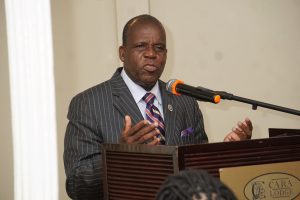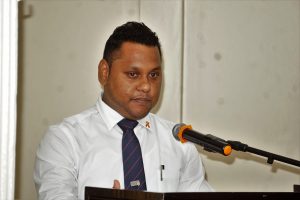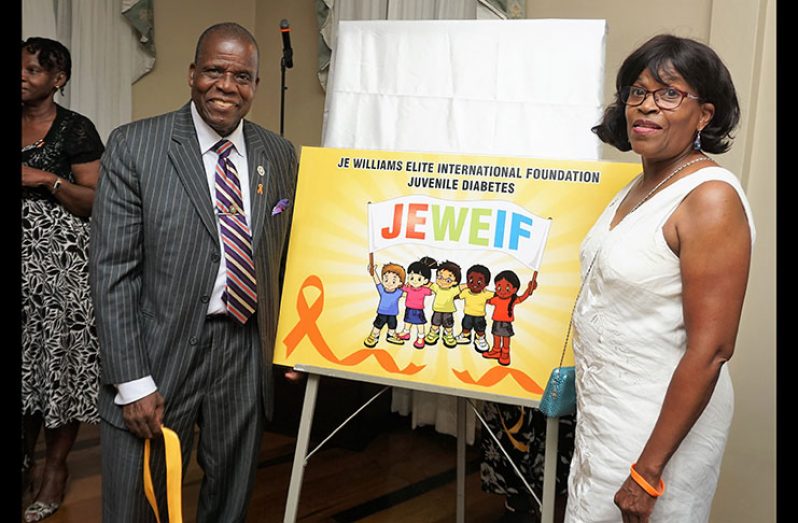Plans to prevent, manage and reverse diabetes
By Elvin Carl Croker
THE JE Williams Elite International Foundation (JEWEIF) in affiliation with New Creation Community Health Empowerment Inc. (NCCHEI) held a ribbon cutting dinner launch of the Juvenile Diabetes Foundation.
The event, which marks the foundation’s first annual dinner for children living with diabetes, was held at the Cara Lodge Hotel in Quamina Street, Georgetown last Saturday evening.

The main aim of the foundation is to help fight the battle against Juvenile Diabetes and Defeat It.
Founder of the foundation June Williams on reflecting on how she came up with the initiative, related that it was while visiting the Georgetown Public Hospital Corporation (GPHC), that she visited the pediatric ward and observed a number of children who were amputees.
“A few of the children said hellos to me with sadness in their eyes which brought sadness and tears to my heart. I later found out that the loss of their limbs was as a result of diabetic complications,” she said.
This she said inspired her to form the foundation since after she left the hospital, the images of the children’s faces stuck with her.
“So on my return to the USA the foundation was established to help fight the battle against
Juvenile Diabetes and defeat it,” she related.
The foundation hopes to do so by initiating the objective to educate the public on signs and symptoms of diabetes with action plans, to create the spiritual, physical and emotional environment for nurturing children with Juvenile Diabetes and other illnesses. The foundation will also establish collaborative efforts with Government and NGOs, religious institutions, school systems, medical institutions and business sectors to raise awareness and sponsoring seminars, workshops, health expos and symposia to motivate and empower people to fight and win the battle on diabetes.
Public Health Specialist and founder of the NCCHEI John Williams in his keynote address said diabetes can be reversed.
Having been a diabetic himself and having a son who was diagnosed with Type 1 Diabetes at age 11, and also having both his grandmother and mother die of Diabetes, Williams said he is now back to a none diabetic level of haemoglobin A1 C, a feat he felt all others with diabetes can achieve.

“Not because one is pre genetically disposed to a condition one has to suffer from it. My remedy was to reverse the path that it took me to get there and within a few months, I was able to come off all medications, he said.
The health specialist said apart from Type 1 and Type 2, there is also Types 3 and 4 Diabetes. He said type four is known as the ‘flat bush diabetes’ otherwise known as ketosis type two diabetes.
“Diabetes is preventable, manageable and reversible and could be beaten and with this initiative, we are going to bring down this crisis with our children and stop diabetes,” he emphasised.
He warned children who don’t know that they are diabetic and have high levels of sugar are the ones who are caught up in the trap of getting amputated when they are injured.
Meanwhile, Dr. Charles Persaud of the Paediatric ward of the GPHC said Juvenile Diabetes is one of the saddest childhood chronic diseases because of the life-changing effect it has on the children and their families.
He noted that at the Paediatric and Chronology clinic, patients are managed and follow up by a chronologist, a dietitian, an ophthalmologist and a general paediatrician.
Additionally, he said the Ministry of Public Health Chronic Disease Annual Diabetic Youth Camp help to share information along with support from the Guyana diabetic association which would assist with materials to the patients.

He related that many times Type 1 A DM or childhood diabetes would be discovered in a child only after they would have visited the hospital for various complaints.
“Almost all the patients seen at the ward would come with a high level of icons in the body which involves multiple system changes and if not treated can lead to death. This is one of the hardest things we would have to tell the children and their parents,” he said.
He said that the diagnosis presentation is bimodal, that is, it peeks mostly between the ages of four and six or early puberty between the ages 10 to 14 and overall, 45 percent of the children present before the age of 10.
Children would present with headaches diarrhoea, vomiting, back pains or their parents would endure them waking up in the night drinking water, going to the washroom regularly, eating a lot but losing weight.
He related that because of a genetic predisposition, only 0.4 percent of the children admitted never had a family member with diabetes. However, offspring of an affected mother are usually one to four percent and offspring of an affected father three to eight percent and offspring of both parents affected with diabetes are more than 30 percent likely of becoming diabetic.

The main goal of treatment of the Paediatric Department after diagnosing the patients, he related, is balancing the goal of a strict lifestyle control; setting realistic goals for each child and their family and their economic status; training the patient and family with appropriate daily diabetic care in order to obtain post control within the normal range of predetermined goals that are realistic to the family and their economic status; and maintaining normal growth and development and emotional maturation with increased in independent and self-care of their complications.
“However, the fundamental element of treatment that we try to instill is the education of the child and family and their importance of diet and of using their medication. In children, it is very hard for the parents to look at their child getting an injection two times a day and checking for blood sugar three times a day. Because of this, most parents discard the treatment because of the sadness and the pain of their child and you wouldn’t see them back after two weeks, months or years, so with the foundation being on board we congratulate them for taking up this noble challenge in helping the hospital prevent the procurement of diabetes and its complications in Guyana and helping to make our future generation happy,” he said.



.jpg)









